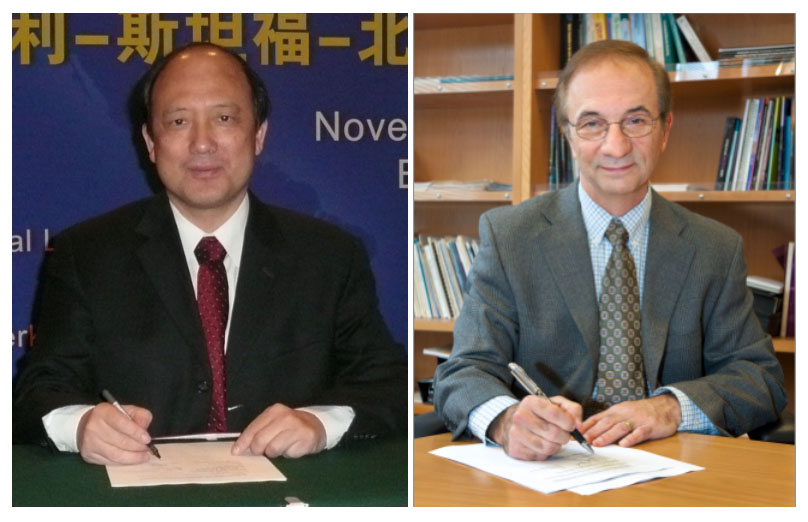Contact: Dan Krotz [email protected] (510) 486-4019
Lawrence Berkeley National Laboratory and China’s Peking University agreed on Nov. 12 to jointly pursue the development of safe and effective carbon capture and storage techniques.
This technology holds strong promise to help mitigate climate change by capturing carbon dioxide from major sources, such as coal-burning power plants, and injecting it deep underground for permanent storage.

Berkeley Lab and China's Peking University will jointly tackle carbon capture and storage research, thanks to a memorandum of understanding signed by Shiyi Chen (left), dean of the College of Engineering at Peking University, and Don DePaolo, director of Berkeley Lab’s Earth Sciences Division.
A memorandum of understanding (MOU) was entered into between the University of California, which manages Berkeley Lab, and Peking University. It was signed by Don DePaolo, director of Berkeley Lab’s Earth Sciences Division and a professor of Earth and planetary science at the University of California, Berkeley, and Shiyi Chen, dean of the College of Engineering at Peking University.
The collaboration was cemented at the U.S.-China Workshop on Carbon Capture & Storage, a two-day event sponsored by the Philomathia Foundation through a grant to UC Berkeley. The workshop, held at Peking University, brought together scientists from Berkeley Lab, Stanford University, and several Chinese research institutions.
“The MOU is a formalization of our intent to jointly use our resources and share information so that we can pursue research that will help accelerate the deployment of carbon capture and storage in both countries over the next 10 to 20 years,” says DePaolo.
The importance of the memorandum of understanding is underscored by the fact that the U.S. and China together are responsible for 40 percent of the world’s emissions of carbon dioxide, a greenhouse gas derived from the combustion of fossil fuels. Compounding the problem, fossil fuels such as coal are likely to remain cheap and plentiful source of energy for decades to come — thus continuing their potential contributions to climate change.
“Carbon capture and storage may be a very effective technology, especially over the next 100 years, in reducing the amount of carbon that is introduced into the atmosphere as a result of energy production,” adds DePaolo.
In order for carbon capture and storage to have a significant impact on the reduction of greenhouse gas emissions, advances are needed in both the capture technology and in the understanding of subsurface processes related to carbon dioxide injection, trapping, and monitoring.
In this vein, future projects facilitated by the memorandum of understanding could include joint carbon capture and storage tests, research on identifying the best storage sites, and the development of computer models of storage site performance, to cite a few examples.
The Berkeley Lab-Peking University collaboration is the latest milestone in Berkeley Lab’s role as a leader in geologic carbon storage research over the past decade.
Earlier this year, Berkeley Lab became home to the Center for Nanoscale Control of Geologic CO2, one of 46 Energy Frontier Research Centers established by the Department of Energy. Scientists at the center probe the fundamental chemical, physical, and biological processes that control the movement of carbon dioxide fluids in the Earth.
Another Energy Frontier Research Center, which focuses on capturing CO2 from power plants and natural gas emissions, is located at the University of California, Berkeley.
Additional information:
- More about the U.S.-China Workshop on Carbon Capture & Storage
- More about the Center for Nanoscale Control of Geologic CO2
- More about Berkeley Lab’s geologic carbon sequestration program
- More about the Philomathia Foundation